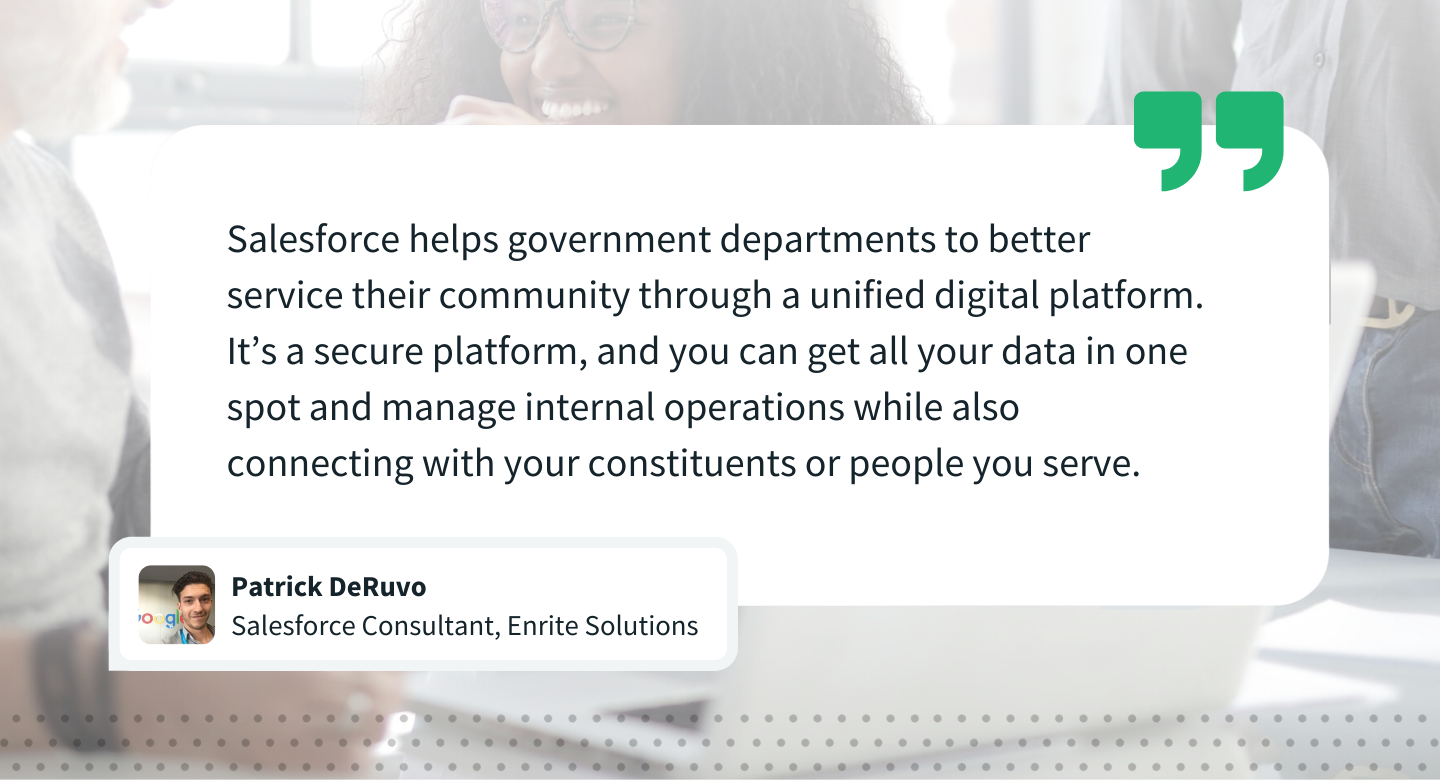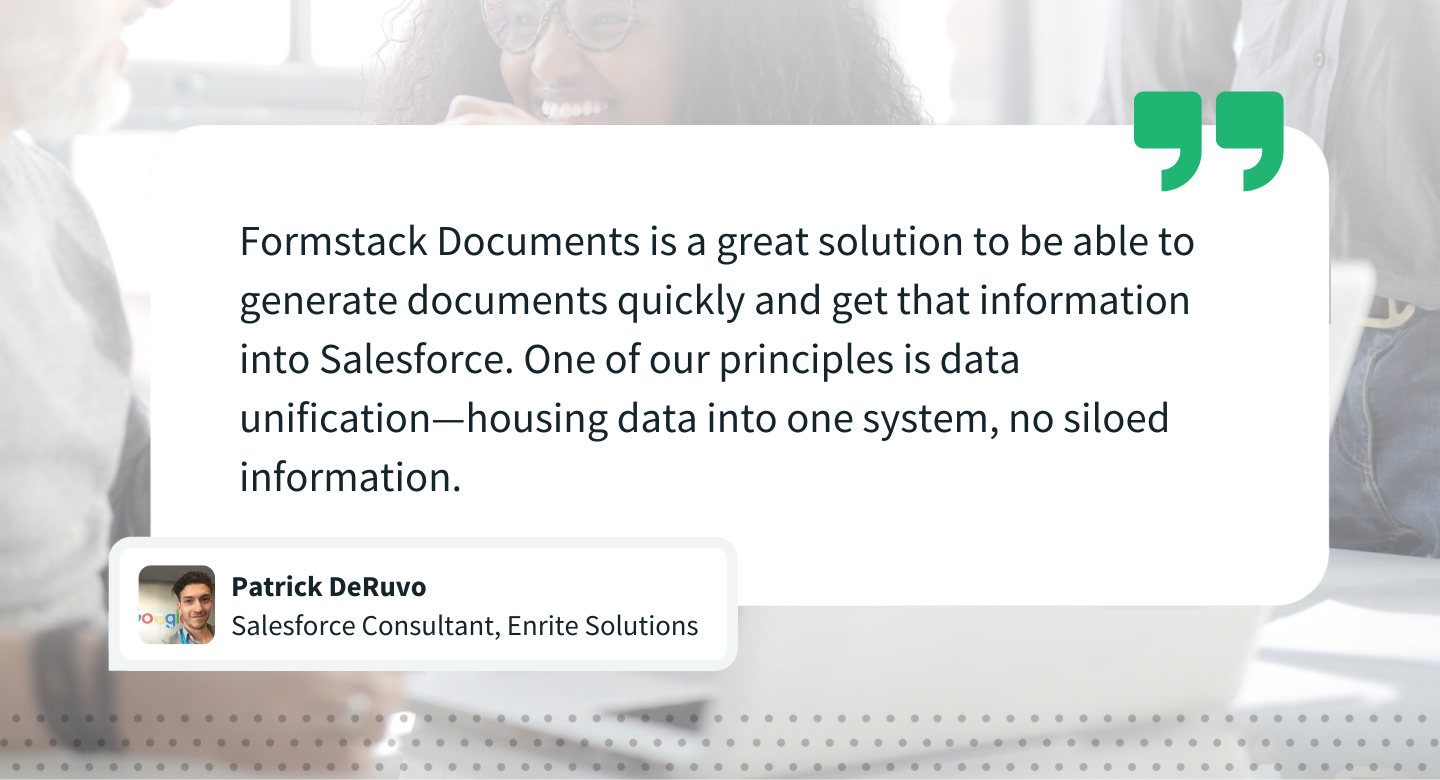Our VP of Partnerships Zak Pines recently sat down with Patrick DeRuvo, Salesforce Consultant from Enrite Solutions, as part of our ongoing Partner Interview Series. Zak and Patrick had a far-ranging conversation that touched on digital transformation in the government and disability sectors, data unification, and streamlining business processes with Formstack. Here’s an abridged transcript of the chat.
Background on Enrite Solutions
Zak: Can we get started by sharing background on Enrite Solutions?
Patrick: Enrite was formed about eight years ago as a Salesforce-focused consulting firm. Our two founders had the opportunity to implement a CRM for a government department, and they found Salesforce and fell in love with it. From that point, Enrite Salesforce has grown with focus on the government and disability sectors. We are based in Adelaide (Australia) and have clients across the country.
Zak: I haven’t heard of Adelaide. What is Adelaide like?
Patrick: We have a population of 1.2 million people. It’s a beautiful place. There are beaches. We’re 15 minutes from the city, and 15 minutes in the other direction, you’re in the hills. We have vineyards all around the city, and we have a few winery clients. Because of our location, we tend to be able to do consulting work for a lower rate than some of our counterparts in eastern states.
Zak: How did you get into the CRM consulting space? What is your background?
Patrick: When I was younger, I worked for some startup companies. I founded one and was a very early employee at another. The first was a location-based marketing company where we connected shoppers with merchants through real-time push notifications when the shopper was near the store. As a shopper would walk past the store, they would get a notification that matched their preferences. I went through a few accelerator programs with that company.
Recently, I worked for a startup that was a network of freelance accountants across Australia, United States, United Kingdom, and Canada. We managed a network of accountants on the Salesforce platform, and that’s where my first connection with Salesforce occurred. I developed most of that system, and we used Sales Cloud, Service Cloud, and Community Cloud to build up that community of freelance accountants around the world.
And then since joining Enrite Solutions, I’ve moved over to Salesforce implementations. I’ve been loving it, as I get to work on a variety of areas—the business internally, client facing, and marketing as well.
Zak: What attracted you to Enrite Solutions?
Patrick: I was a Salesforce customer for years and got to know the partner landscape. Enrite felt like the right choice; they were the biggest partner, they were part of the community, and I started a user group in Adelaide and Enrite was a sponsor.
Zak: What does your day-to-day look like in your role?
Patrick: I wear quite a few hats. I work on internal projects around business and process improvement to make sure our processes are streamlined and provide the best value for our clients in the most efficient way. Another part of my day is marketing, such as email campaigns, writing blogs, and more strategic marketing. And then the last part is centered around client projects, working as a project manager and business analyst to help our clients and make sure projects are moving along well.
Government Customers & the Move to Paperless
Zak: You mentioned that government is an industry focus for you. What is your experience working with government customers in Australia?
Patrick: One of the first clients at the firm was a government client. From the success of that project, we received a few referrals, which led us to have more government clients.
Salesforce helps government departments to better service their community through a unified digital platform. It’s a secure platform, and you can get all your data in one spot and manage internal operations while also connecting with your constituents or people you serve.

Zak: Do you find governments are moving more to digital as a general trend?
Patrick: Absolutely. Traditionally, the commercial sector is the one to move first, but cloud has been around for so long that the government is moving to cloud to better service their constituents. As a user, we’re used to excellent customer service from a lot of big companies, and we’re used to digital pathways to interact. A lot of government departments have realized this in the last five years and have wanted to offer that to the people in their community and the people that they serve.
Zak: With COVID-19, we’re seeing further acceleration of governments moving to paperless processes. Are you seeing something similar?
Patrick: Yes, and it goes way beyond government. A lot of government departments are looking to be able to continue to do what they do in a digital format, but that goes for our commercial clients as well. For some of them, it’s their first time working at home, so they’ve had to institute rapid digital transformation. We’ve got some new and old clients looking to facilitate that with Salesforce. We’re fortunate as we were already equipped to work from home, and now we’re bringing that learning and knowledge to our clients.
Zak: You also mentioned disability. Can you tell me more about this sector?
Patrick: We do a lot of work in the disability sector and nonprofits in general. In Australia, we have the NDIS, which provides support for disabled persons. A lot of the companies that work in this sector need to coordinate with a lot of different entities. They’ll need to coordinate with the insurer, the government departments, and the insurance agency. There are a couple of great solutions through Salesforce that allow them to do this in a totally digital way. Often, like many businesses, they’ll need to send out assessments or contracts, generate documents, and get those documents signed—so this is a great use case for Formstack Forms, Formstack Documents, and Formstack Sign together.
Discovering Formstack
Zak: When did you first come to discover Formstack?
Patrick: At my previous company, Accodex Partners, we were a network of freelance accountants. We had clients around the world in every industry. Often when it was a simple tax return, we’d need to collect a standard set of information. I didn’t want our accounting partners having to ask the same questions over and over and then manually input that data into Salesforce. So we put together a solution using Formstack.
We would create a bunch of surveys and use a template, and the accountants could use these and send them to clients as part of our client onboarding procedure. We would have a standard set of information, and it was attached to the client’s account in Salesforce. The client would fill the survey out, and we’d get notified when it all happened—easy. This made it so much more efficient, and you could move onto the next step in the process and keep it moving.
Zak: Great use case. So you knew Formstack, and then you joined Enrite who is a Formstack partner?
Patrick: Yes. I was pleased to find out that Enrite was already a Formstack partner, and they are big users of what was formerly WebMerge and is now your Formstack Documents product. That was a solution I was looking for at my previous role. Enrite nailed that use case as a lot of businesses need to generate documents with information that’s in their CRM system.
Formstack Documents is a great solution to be able to generate documents quickly and get that information into Salesforce. One of our principles is data unification—housing data into one system, no siloed information. That has a lot of benefits beyond generating documents quickly. It also has a positive impact on reporting and analytics. It gives a 360-degree view of your customer. It makes sense to house your data in one system— get it in with Formstack Forms and get it back out with Formstack Documents.

Zak: Have you had experience with Formstack Sign, our eSignature solution?
Patrick: Absolutely. That’s the natural extension of Formstack Documents, as usually when you are sending a document it’s tied to capturing a digital signature. If they need to sign off on an assessment, which is the case often in the disability sector, you don’t want them to have to print, sign, scan, and then email back to you. As we all know, people put that admin stuff off for a number of days, and it slows down the process. So having the ability with Formstack Sign moves processes along at a faster clip.
Zak: What’s ahead for Enrite Solutions?
Patrick: We’re looking to grow our diverse range of certifications. We’re fortunate we have a big team, all based in Adelaide, with one in Melbourne. We have a lot already, but we’re looking to grow that so we’re certified in more Salesforce products.
We’ve done over 200 Salesforce implementations to date, so we’ve seen a lot, and we tend to come up against the same client challenges. A client, for example, may want to connect to their accounting system. It’s a common use case, and we’ve seen it a bunch. We’re just now starting to create solutions that we can deploy to clients without having to go through the development cycle every time with a new client. We’re building a repository of solutions that we can offer clients at a less expensive rate. This means clients get value a lot quicker, and we’re able to deliver solutions at a more affordable rate. Formstack ties to that because Formstack allows us to deploy solutions with configuration instead of code.
Lighting Round
Zak: Let’s wrap up with the Lighting Round! What are some of your personal interests or hobbies?
Patrick: Pre-coronavirus, skiing was right up there. I’ve been to Canada, South Korea, New Zealand, and a lot of ski hills in Australia. Right up there with soccer as well—I used to play professionally when I was younger, so I still try to get out and kick the ball when I can.
Zak: Do you have a productivity tip you can share?
Patrick: My biggest game changer when it comes to productivity is a morning routine. When I implemented that in my life a number of years ago, I noticed a huge uptick in productivity. A good morning starting with making your bed. If you’re coming home to a made bed, that’s part of a good day. An hour to yourself in the morning to do everything you need to do makes a huge difference.
Zak: What’s your favorite TV show?
Patrick: At the moment, I would have to say “Westworld.” Based on a really old movie, it’s about robots that have an artificial intelligence inside them and slowly become conscious.
Zak: What’s your go-to lunch during the work day?
Patrick: Lately, during the lockdown, we’re allowed out once a day for food and essentials. So I’ve been going to the cafe around the corner pretty religiously, and they have some cool toasties there.
Zak: We have a debate within Formstack and want your view from across the world. Is a hot dog a sandwich?
Patrick: No, a hot dog is not a sandwich. I think if you’re talking about a broad sandwich—a broad group of food that will be considered a sandwich—I think the common usage is filling between two slices of bread. A roll falls outside of that, which is why I would say no, a hot dog is not a sandwich.
Looking for your next step? Check out Formstack’s partner program for consultants, agencies, and tech partners.











